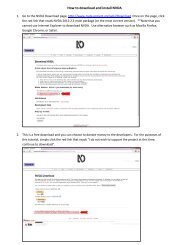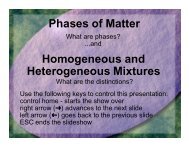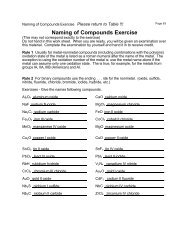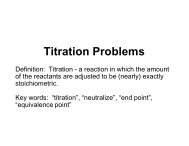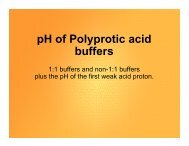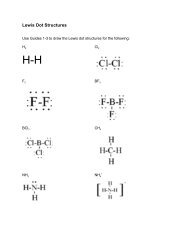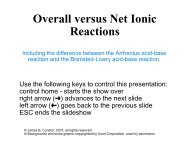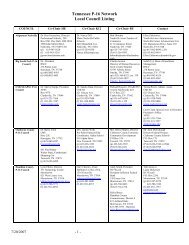Lewis Dot
Lewis Dot
Lewis Dot
Create successful ePaper yourself
Turn your PDF publications into a flip-book with our unique Google optimized e-Paper software.
<strong>Lewis</strong> <strong>Dot</strong> 6 - Resonance<br />
Two or more equivalent structures with double bonds<br />
Index:<br />
A Rule 6 - Resonance<br />
B<br />
C<br />
Example 1 - HCO 2 G<br />
Example 2 - C 6 H 6<br />
©copyright by James B. Condon (2013) all rights reserved.<br />
©Some of the graphics are supplied by Corel Corporation with their permission.<br />
Use of these materials by others is encouraged provided these notices are not<br />
altered. Donations to the Roane State Foundations would be appreciated in<br />
order to support the development of these presentations.<br />
Ctrl Home - start<br />
Ctrl End - last slide<br />
º Next slide<br />
» Previous slide<br />
End Stop sound<br />
Home restart sound<br />
ESC - Stop Slideshow<br />
1
<strong>Lewis</strong> <strong>Dot</strong> 6: Resonance<br />
If there are two or more equivalent ways to place<br />
a double bond in a molecule, this is an indication<br />
of resonance. This is shown by drawing all<br />
possibilities and writing a double arrow (ø)<br />
between them.<br />
2
<strong>Lewis</strong> <strong>Dot</strong> 6: Resonance<br />
If there are 2 or more equivalent ways to place a double<br />
bond, this indicates resonance. show all possibilities and<br />
writing a”ø” between them.<br />
Example 1: What is the <strong>Lewis</strong> <strong>Dot</strong> structure of<br />
the HCO 2 G ion?<br />
3
<strong>Lewis</strong> <strong>Dot</strong> 6: Resonance<br />
If there are 2 or more equivalent ways to place a double<br />
bond, this indicates resonance. show all possibilities and<br />
writing a”ø” between them.<br />
Example 1: What is the <strong>Lewis</strong> <strong>Dot</strong> structure of<br />
the HCO 2 G ion?<br />
Here is the structure using rules 1 - 6:<br />
H–C<br />
O<br />
O:<br />
4
<strong>Lewis</strong> <strong>Dot</strong> 6: Resonance<br />
If there are 2 or more equivalent ways to place a double<br />
bond, this indicates resonance. show all possibilities and<br />
writing a”ø” between them.<br />
Example 1: What is the <strong>Lewis</strong> <strong>Dot</strong> structure of<br />
the HCO 2 G ion?<br />
Here is the structure using rules 1 - 6:<br />
H–C<br />
O<br />
O:<br />
H–C<br />
O<br />
O:<br />
But why is the “=” to top and not bottom “O”?<br />
5
<strong>Lewis</strong> <strong>Dot</strong> 6: Resonance<br />
If there are 2 or more equivalent ways to place a double<br />
bond, this indicates resonance. show all possibilities and<br />
writing a”ø” between them.<br />
Example 1: What is the <strong>Lewis</strong> <strong>Dot</strong> structure of<br />
the HCO 2 G ion?<br />
Here is the structure using rules 1 - 6:<br />
H–C<br />
O<br />
O:<br />
H–C<br />
O<br />
O:<br />
The answer: “They are both correct.”<br />
6
<strong>Lewis</strong> <strong>Dot</strong> 6: Resonance<br />
If there are 2 or more equivalent ways to place a double<br />
bond, this indicates resonance. show all possibilities and<br />
writing a”ø” between them.<br />
Example 1: What is the <strong>Lewis</strong> <strong>Dot</strong> structure of<br />
the HCO 2 G ion?<br />
Here is the structure using rules 1 - 6:<br />
H–C<br />
O<br />
O:<br />
ø<br />
H–C<br />
O<br />
O:<br />
Therefore, show both with a “ø” between them.<br />
7
<strong>Lewis</strong> <strong>Dot</strong> 6: Resonance<br />
If there are 2 or more equivalent ways to place a double<br />
bond, this indicates resonance. show all possibilities and<br />
writing a”ø” between them.<br />
Example 2: What is the <strong>Lewis</strong> <strong>Dot</strong> structure of<br />
the C 6 H 6 molecule (a ring molecule)?<br />
8
<strong>Lewis</strong> <strong>Dot</strong> 6: Resonance<br />
If there are 2 or more equivalent ways to place a double<br />
bond, this indicates resonance. show all possibilities and<br />
writing a”ø” between them.<br />
Example 2: What is the <strong>Lewis</strong> <strong>Dot</strong> structure of<br />
the C 6 H 6 molecule (a ring molecule)?<br />
Here is the structure using rules 1 - 6:<br />
H<br />
H<br />
H<br />
C<br />
C C<br />
C C<br />
C<br />
H<br />
H<br />
H<br />
9
<strong>Lewis</strong> <strong>Dot</strong> 6: Resonance<br />
If there are 2 or more equivalent ways to place a double<br />
bond, this indicates resonance. show all possibilities and<br />
writing a”ø” between them.<br />
Example 2: What is the <strong>Lewis</strong> <strong>Dot</strong> structure of<br />
the C 6 H 6 molecule (a ring molecule)?<br />
Here is the structure using rules 1 - 6:<br />
H<br />
H<br />
H<br />
C<br />
C C<br />
C C<br />
C<br />
H<br />
H But, why<br />
not this? !<br />
H<br />
H<br />
H<br />
H<br />
C<br />
C C<br />
C C<br />
C<br />
H<br />
H<br />
H<br />
10
<strong>Lewis</strong> <strong>Dot</strong> 6: Resonance<br />
If there are 2 or more equivalent ways to place a double<br />
bond, this indicates resonance. show all possibilities and<br />
writing a”ø” between them.<br />
Example 2: What is the <strong>Lewis</strong> <strong>Dot</strong> structure of<br />
the C 6 H 6 molecule (a ring molecule)?<br />
Here is the structure using rules 1 - 6:<br />
H<br />
H<br />
There is no<br />
H<br />
C<br />
C C<br />
H difference, H<br />
C<br />
C C<br />
C C<br />
so insert<br />
C C<br />
H H “ø” H C<br />
C<br />
H<br />
H<br />
H<br />
H<br />
11
<strong>Lewis</strong> <strong>Dot</strong> 6: Resonance<br />
If there are 2 or more equivalent ways to place a double<br />
bond, this indicates resonance. show all possibilities and<br />
writing a”ø” between them.<br />
Example 2: What is the <strong>Lewis</strong> <strong>Dot</strong> structure of<br />
the C 6 H 6 molecule (a ring molecule)?<br />
Here is the structure using rules 1 - 6:<br />
H<br />
H<br />
H<br />
C<br />
C C<br />
C C<br />
C<br />
H<br />
H<br />
H<br />
ø<br />
H<br />
H<br />
H<br />
C<br />
C C<br />
C C<br />
C<br />
H<br />
H<br />
H<br />
12
<strong>Lewis</strong> <strong>Dot</strong> 6 - Resonance<br />
Two or more equivalent structures with double bonds<br />
THE END<br />
Control KEYS:<br />
Ctrl Home - start<br />
Ctrl End - last slide<br />
º Next slide<br />
» Previous slide<br />
End Stop sound<br />
Home restart sound<br />
ESC - Stop Slideshow<br />
13



